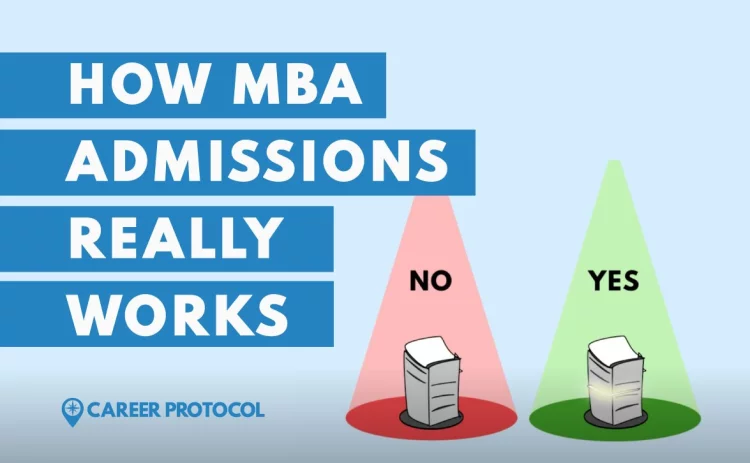Hi there! I’m Angela Guido, the founder of Career Protocol, and for the last 15 years, I’ve dedicated my career to helping ambitious leaders achieve their own career dreams, most notably, through admission to the world’s top MBA programs.
Let me answer three questions today that will put your mind at ease and help you succeed in your MBA application.
How do MBA Admissions really work?
If you prefer video, this one explains it all:
While each business school has its own process for evaluating candidates that is both holistic and iterative, an easy way to think about the process is like this:
Step 1: Someone reads your entire MBA application.
No matter what your grades and scores are, the school’s admissions officers read ALL your MBA essays and recommendations. They give each applicant an equal chance to show them who you really are. At this stage, there may be only one reader or two independent ones.
Step 2: After the first read, your application lands in one of two piles: yeah or nay.
At this stage, the nay pile is also the ding pile, so if you get a nay here, that’s probably it for you. If you’re in the yeah pile, then you advance to the next step.
Step 3: Your interview with the school.
Step 4: The admission committee makes a final decision.
Remember we’re still playing a game of piles. At this final stage, they are sorting all the candidates into final piles. They need to determine who ends up in the final yeah pile, who remains in limbo (the waitlist pile), and who has to move over to the ding pile. This committee decision could theoretically be digital, with some kind of calculation and weighted algorithm of yeahs and nays, but more likely, in most cases, it’s still a real committee discussion around a virtual table.
This last step is the hardest to understand, but you can think of it like packing for a long trip with only one carry-on suitcase. They have to cram as many interesting, strong, and different candidates as possible into the fixed number of admits they will take (~500 total admits for Stanford, ~1,000 for Booth, etc.). They start with the people they love – the yeah pile post-interview – then the Adcomm winnow it down to the right number, taking into account a variety of dimensions of diversity: academic background, industry experience, gender, nationality, other demographics, etc.
That means that the final decision depends not only on you, the strength of your candidacy, and how well you performed in the interview. It also depends on who else is still in the yeah pile. If there are a lot of other people more or less like you in that pile, that means more of you will have to be jettisoned to the ding pile so that class diversity can be preserved. At this end stage of the process, you’re competing most directly only with other people who share your various background classifications.
How do I get into my favorite MBA programs?
Tactically, you get there in 3 steps:
- Don’t get knocked out in the first round for too many major weaknesses in your candidacy. Everyone is allowed one weakness. A major weakness or having more than one puts you at risk.
- Crush the interview.
- Be someone the admissions committee genuinely loves throughout every aspect of the application so that in the final tally, you’re one of the few who stay in the Yes Pile.
If you do those three things, you’re in.
The third and final step is the most important -- being a candidate the admissions committee loves. That’s why your ultimate success in MBA applications depends on things like your passions and character, your specific achievements, your unique fit with the school, and all the elements of MBA application execution that can make the difference between a big fat Yes and a ding.
But that is a topic for another article.
Your next step is to figure out how to stay in the yeah pile until the last step. The answer to that question depends on calculating your chances of MBA admission, or your MBA admission odds.
How can I understand my MBA Admission odds?
Your odds depend on your statistics. Whether you will get chucked into the ding pile in step 1 or in step 3 because of a major weakness or too many small weaknesses comes down to what you look like on paper.
You’ve got to start by looking at your basic statistics. Then do your best to improve those as much as you can. Then shift your attention to your intangibles and construct an inspiring application that showcases your best self.
If you want a read on BOTH your MBA odds and some of the positive intangible qualities your MBA application presents, then look no further than MBAmo, the MBA Admissions Calculator Robot brought to you by my team at Career Protocol.
Just take 60 seconds to enter a little information about your background and experience, and MBAmo will generate a 20+ page customized report on your MBA odds, the competitiveness of your profile across a variety of dimensions, and the things you can do to strengthen your candidacy before you apply to business school. He’s pretty cool, and we built him with a ton of love!
Please check it out! And if you ever want to talk directly with me or a member of my team about your entire MBA candidacy and bring in elements of your story, your career vision, and your character that will determine your ultimate success in MBA applications, then talk to us any time!



